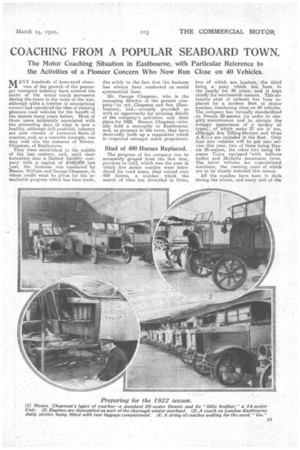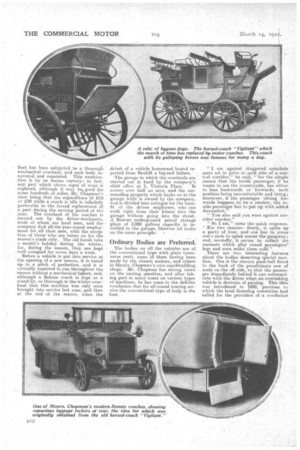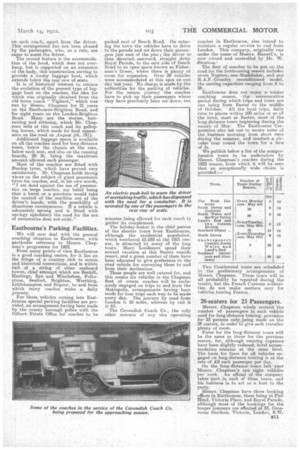COACHING FROM A POPULAR SEABOARD TOWN.
Page 13

Page 14

Page 15

If you've noticed an error in this article please click here to report it so we can fix it.
The Motor Coaching Situation in Eastbourne, with Particular Reference to the Activities of a Pioneer Concern Who Now Run Close on 40 Vehicles.
MANY hundreds of keen-eyed obser. vers of the growth of the passenger transport industry have entered the ranks of the motor coach . movement during the years in the wake of the war, although quite a number of enterprising owners had conceived the idea of running pleasure road vehicles for the benefit of the masses many years before. Most of those users intimately associated with the pioneering days of what is now a healthy, although still youthful, industry are now owners of extensive fleets of coaches, and as a concrete example, one may well cite the instance of Messrs. Chapman, of Eastbourne.
They were establish..i.d in the middle of the last .century, and, until their formation into a limited liability company with a, capital of £100,1000 last year, the busine,ss was conducted by Messrs. William and George Chapman, to whom credit must be given for the remarkable progress which has been made,
due solely to the fact that the business has always been conducted on sound syste-matical lines.
Mr. George Chapman, who is the managing director of the present company—to wit, Chapman and Son (Eastbourne), Ltd.—recently provided us with an opportunity for securing details of the company's activities and their plans for 1042. Messrs. Chapman virtually hold a monopoly in Eastbourne, and, as pioneers in the town, they have deservedly built up a reputation which is respected amongst coach proprietors.
Stud of 400 Horses Replaced.
The progress of the company can be accurately gauged from the fact that, previous to 111, which was the year in which five motor coaches were introduced for road tours, they owned over 400 horses, a number which the march of time has dwindled to three, two of which are hunters, the third being a pony which has been in the family for 34 years, and is kept, chiefly for sentimental reasons. This extensive stud of animals has been ro. placed by a modern fleet of motor coaches, numbering close on 40 vehicles. The company has virtually standardized on Dennis 28-seaters (in order to simplify maintenance and to obviate the scrappy appearance of is medley of types), of which make 27 are in use, although five Tilling-Stevens and three A.E.C.s are included in the fleet. Only four new vehicles will be put into service. this year, two of these being Dennis 28-seaters, the other two being 14seater Unies equ'pped with bulbous bodies and Michelin pneumatic tyres. The latter vehicles are experimental machines, the running costs of which are to be closely watched this season.
All the coaches have been in dock during the winter, and every unit of the fleet has been subjected to a thorough mechanical overhaul, and each body renovated and repainted. This examination is by no means cursory; in fact, an,y part which shows signs of wear is replaced, although it may be, good for some hundreds of miles, Mr. Chapman's view being that the expenditure of £10 or £20 while a coach is idle is infinitely pieferable to the forcedreplacement of a part during the earning period of the year. The overhaul of the coaches is carried out by the driver-mechanics, most of whom are .local men, and• the company find all-the-year-round employment for all their,men, with the exception of those Who are taken on for the season's trade only. The old bands take st month's holiday during the winter, for, during the season, they. are kept well occupied for seven days a week. Before a vehicle is put into service at the opening of a new season, it is tuned up to a pitch of perfection,_and it is virtually expected to run throughout the season without a mechanical failure, and, although a Belsize coach is Kept as a stand-by, so thorough is the winter overhaul that this machine was only once brought into service last year, and then at the end of the season, when the driver of a vehicle homeward bound reported from Bexhill a big-end failure. The garage in which the overhauls are carried out is hard by the company's chief office at 1, Victoria Place. It covers over half an acre, andthe surrounding property which backs on to the garage walls is owned by the company, and is divided into cottages for the benefit of the driver employees, who can walk right from their homes into the garage without going into the street. A Bowser underground petrol storage plant of 3,000 gallons capacity is installed in the garage, likewise oil tanks on the same principle.
Ordinary Bodies are Preferred.
The bodies on all the vehicles areof the conventional type withplain transverse seats, some of them haying been made by the chassis makers, and others in Messrs. Chapman's own coachbuilding shops. Mr. Chapman has strong views on the seating question, and after taking part in many tours on various types ofmachines, he has come to the definite conclusion that for all-round touring service the conventional type of body is the best. " I am against staggered armchair seats set in pairs ateach side of a eon:bat corridor,'' he said, " for the simple reason that the inside passenger, if he wants to see the countryside, has either to lean backwards or forwards, each position being uncomfortable and tiring; moreover, if the passenger sitting forwards .happens to -bea smoker, the inside passenger has to put up with added discomfort."
"You also said you were against corridor coaches."
"So I am," came the quick response. " For two reasons—firstly, it splits up a party of four, and one has to crane one's neck to speak across the gangway; and, secondly, it serves to collect air currents which play round passehgere legs and soon make them cold."
There are two interesting features about the bodiesdeserving special mention. One is the electric push-bell fitted to the back of the penultimate row of seats on the off side, so that the passenger immediately behind it can communicate with the driver when an overtaking vehicle is desirous of passing. This idea was introduced in 1920, previous to which the local licensing committee had called for the provision of a conductor on each coach, apart from the driver. This arrangement has not been abused by the passengers, who, as a rule, are eager to assist the driver.
The second feature is the accommodation of the hood, which does not overhang, but is supported on an extension of the body, this construction serving to provide a roomy luggage boot, which extends below the rear row of seats.
It is of historical interest to retrace the evolution of the present type of luggage boot on the coaches,. the idea for which was originally obtained from the old horse coach " Vigilant," whichwas run by Messrs. Chapman for 21 years on the Eastbourne-Brighton Road, and for eight years on the London-Brighton Road. Many are the stories, hairraising and amusing, which Mr. Chap-man tells pf this coach and its galloping horses, which made its final appearance on the road on August 4th, 2014.
Additional luggage space is available on all the coaches used for long-distance tours, below the chassis at the rear, below each seat, and also on the running hoards, 20 lb. being the maximum amount allowed each passenger.
Most of the coaches are fitted with Dunlop tyres, which have proved very satisfactory. Mr. Chapman holds strong views on the subject of giant pneumatic tyres for coaches, and, in his own.words, "I am dead against the use of pneumatics on large coaches, my belief being that a burst or a puncture would take the control of the machine out of the driver's hands, with the possibility of disastrous consequences. If a vehicle is adequately sprung and is fitted with springy upholstery the need for the use of pneumatics does not, exist."
Eastbourne's Parking Facilities.
We will now deal with the general coaching situation in Eastbourne, with particular reference to Messrs. Chapman's programme for 1922.
From many points of view Eastbourne is a good coaching centre, for it lies on the fringe of a• country rich in scenic and historical connections, and is within hail of a stringof. other seaboard towns, chief amongst which are Bexhill, Hastings, Rye and Winchelsea, Folke. stone Seaford, Brighton, Worthing, Littlehamptan and Bognor, to and from which many coaches make a daily Journey.
For those vehicles coming into Eastbourne special parking facilities are provided, an arrangement having been made by the county borough police with the Gilbert Estate Office for coaches to be
parked east of Beach Roach On entering the toWn the vehicles have to drive to the parade and set down their passengers just east of the pier ; the driver isi then directed, eastward, straight down Royal Parade, to the east side of Beach Road to an open space known as Fisherman's Green, where there is plenty of MOM for expansion. Over 30 vehicles were accommodated at this spot on one day last year. Na charge is made by: the authorities for the parking of vehicles. For the return journey the coaches have to pick up their passengers where they have previously been set down, ten
-minutes being allowed for each coach to gather its complement.
The holiday-maker is the chief patron of the shorter tours from Eastbourne, although the residential population, which numbered 62,030 at the 1921 census, is attracted by many of the long tours, Many Londoners spend their annual vacation at this Sussex seaside resort, and a great number of them have been educated to give preference to the road vehicle for conveying them to and from their destination.
These people are well catered for, and this season six vehicles in the Chapman fleet of cream coaches will be exclusively engaged on trips to and from the Metropolis, arrangementshaving been made for four trips each way to be made every day. The journey by road from London is 58 miles, whereas by rail it is 65.
The Cavendish Coach Co., the only other concern of -any size operating coaches in Eastbourne, also intend to Maintain a regular service to and from London. This company, originally 7110 under the name of Messrs. Bassett's' is now owned and controlled by Mr. W. Strettoms
The fleet of coaches to be put on the road for the forthcoming season includes seven Napiersi one. Studebaker, and one R.A.F.-Crossley reconditioned model, the seating capacities ranging from 8 to
Eastbourne does not • enjoy a winter coaching season, the remunerative. period during which trips and tours are run being from Easter to the middle of October. A11 the 'local trips, daily runs to places within 106 miles or so of the town, start at Easter, most of the Ictig-distance tours beginning during the month of May. The Eastbourne Cm.poration also set out to secure some of the business accruing from short runs during the summer, and conduct. a circular tour round the town for a fare of Is.
We publish below a list of the coniprebensive tours to be undertaken by Messrs. Chapman's coaches during this 1922 season, from which it will be seen that an exceptionally wide choice is provided
Two Continental tours are scheduled in the preliminary arrangements of Messrs. Chapman. These tours will in all probability be repeated during the season, but the French Customs authori. ties do not make matters easy for vehicles touring France. •
28-seaters for 23 Passengers.
Messrs. Chapman wisely restrict the number of passengers in each vehicle used for long-distance touring, provision for 23 persons only being made on the 213 seaters, in order to give each traveller plenty of room. Fares for the long-distance tours will be the same as those for -the previous season, for, although running expenses have been slightly reduced, hotel accommodation remains at the same level. The basis for fares for all vehicles engaged on long-distance touring is at the rate of £2 each passenger per day. On the Icing-distance tours last year Messrs. Chapman's ran eight vehicles per week. An official of the company takes part.ineach of these tours, and hisbusiness is to act as a host to the party.
Messrs. Chapman have three booking offices in Eastbourne, these being at Pier Head, Victoria Place, and Royal Parade, although most of the bookings for the longer journeys are effected at 33, Grosvenor Gardens, Victoria, London, S.W.




























